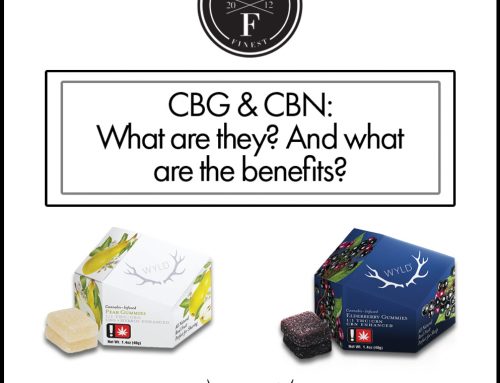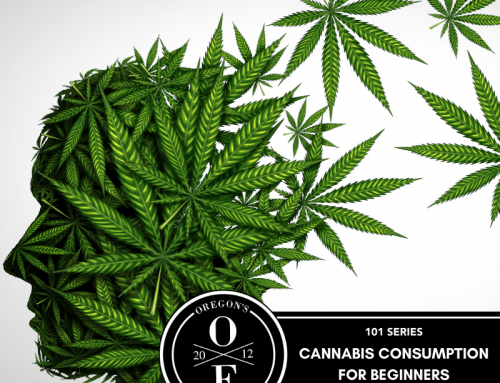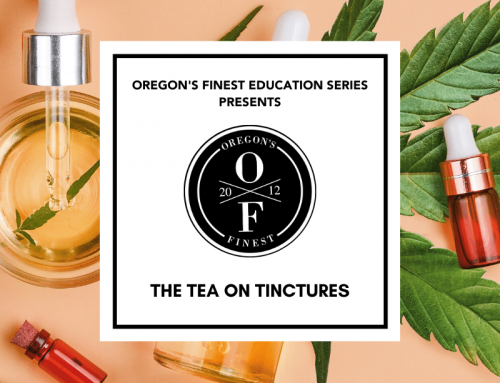Author: Selena Toomey

The effects of isolation & social distancing are beneficial when it comes to preventing or slowing the spread of a highly contagious disease. However, durations of quarantine can have serious repercussions on one’s mental health & should not be disregarded. The following symptoms were most common in a review of the psychological impact of quarantine: anxiety, depression, post-traumatic stress symptoms, avoidance behaviors & anger. [1] I’m hoping the following information will not only be informative but assist in preventing or addressing symptoms you or someone you know may be experiencing. You will find several tips regarding primary chemotypes or chemovars (THC vs CBD) & dominant terpenes. [2] Combinations of terpenes or terpenoids will change the aroma of cannabis varieties, but terpenes also significantly influence the psychoactive & medical effects. [3] You can read more about how cannabis varieties work in our blog post here.
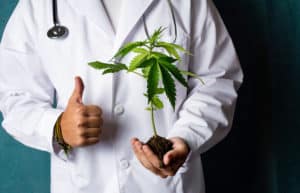
Although cannabis has been used to address symptoms of anxiety & depression for thousands of years, it is always recommended to consult treatment options with a medical professional in advance. Please note, combining medications increases the risk of them interacting with one another & possibly worsening the symptoms, especially if you’re not communicating regularly with a physician. [4], [5], [6]
For further reading on CBD drug interactions, check out the following:
Micro-dosing is key! While cannabis offers many benefits, finding the right therapeutic dose is a very individualized process. Caution is advised, as there is considerable evidence that large doses of cannabis can trigger anxiety and even paranoia in susceptible individuals. Many variables can influence the efficacy & safety, including other medications, conditions, prior exposure, age, route of administration & concentrations. [7] Keep a journal! We don’t have the liberty of cannabis research in America, since the medical benefits of cannabis have been hindered by various federal regulations, including its “Schedule 1” classification. We must rely on our own personal experience with the plant. Please see attached “Cannabis Dosage Journal” [8]
When you consider the feelings associated with anxiety & depression, it’s no surprise to see both at the top of the list of symptoms. Anxiety (much of the time accompanied by depression) [9] can be characterized by feelings of worry, restlessness, and/or fear. While feelings of sadness or loss of interest characterize depression, these feelings can lead to a wide range of behavioral & physical symptoms (changes in sleep, appetite, energy level, concentration, daily behavior, self-esteem… even thoughts of suicide). All of the aforementioned symptoms are commonly treated by self-care, therapy &/or medication. Antidepressants are commonly prescribed & work by targeting the region of the brain responsible for anxiety & depression. [10] [11] Cannabis cultivars rich in limonene are recommended in low doses to combat many of the symptoms associated with anxiety & depression. A known anxiolytic, limonene increases levels of dopamine & serotonin in the brain. Linalool is also known for its antidepressant & calming effects. [12] [13] 2.5 to 5mg of THC inhaled or taken sublingually may be useful in shifting mood. Light doses of CBD 5 to 10mg are recommended for anxiety accompanied by depression. CBD could also be taken as a preventative measure to treat anxiety, as chronic anxiety can be extremely fatiguing. [14] A study from WSU found 1 puff of CBD rich flower was optimal for reducing depression, 2 puffs of any cultivar were sufficient to reduce symptoms of anxiety & 10 puffs of a 1:1 (high in THC & CBD) cultivar produced the largest reductions in stress. [15] The options are truly endless… begin focusing on the aromas & effects of the cultivars you’re choosing. Selecting new varieties based on your findings will be much more beneficial than searching for a specific strain name – or flavor. If you’re new to cannabis & are unsure of what a “low dose” looks like, use a portion of flower equivalent to the size of a match-tip & wait a minimum of 15 minutes before consuming more. Trust your nose, pay attention to your body & be patient!
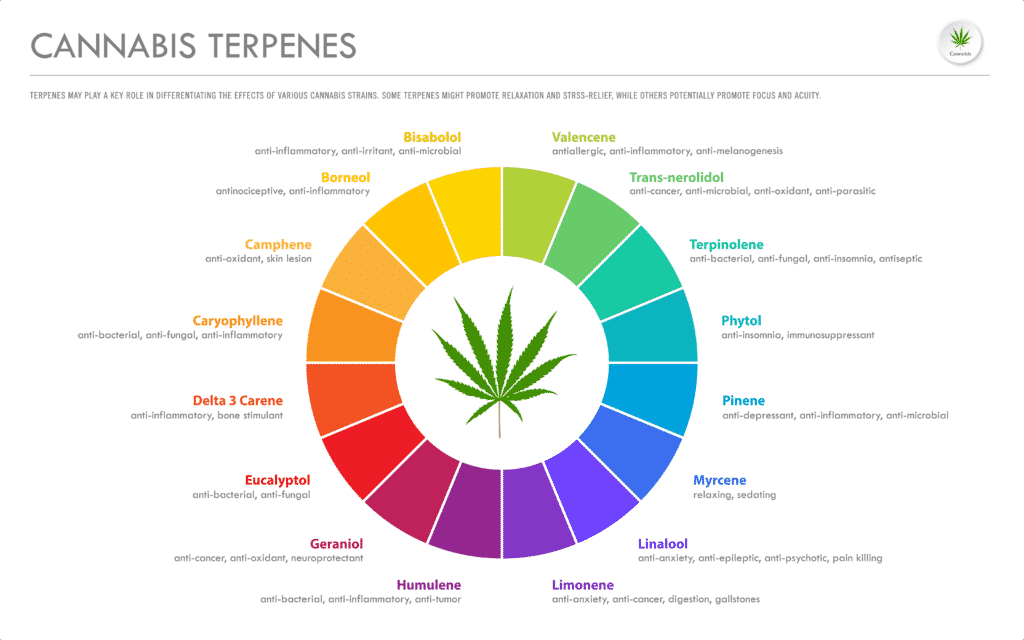
Next on the list, PTS or post-traumatic stress symptoms. The response to PTS symptoms usually involves an intense experience of terror or helplessness. These feelings usually lead to avoidance behaviors & anger. Cannabis can help with many PTS symptoms including sleep disturbances (insomnia & nightmares), a reduction in incidences of flashbacks & hyperarousal, to name a few. [16] [3] Cannabis varieties with linalool (spicy & floral notes; found in lavender, mint, cinnamon & coriander having very strong sedative & relaxing properties) or limonene (citrusy smell that resembles lemons, known to improve mood & reduce stress) are preferred to treat PTS symptoms. Avoid pinene (smells like pine trees) rich cultivars, it could interfere with memory remodeling & fear extinction. Also, avoid myrcene (earthy, musky notes resembling cloves & fruity, red grape-like aroma) during the day, which may have harmful results on patients with suicidal ideations associated with PTS. [17], [18] In addition to avoidance behaviors, symptoms affiliated with PTS often mimic symptoms of anxiety & depression. [19] Again, low doses!
Avoidance behaviors can take three different forms: 1) Complete avoidance (drop a class or quit a job); 2) escape (leaving early or hiding in another room); or 3) partial avoidance (avoiding eye contact or lowering one’s voice). [20] Stress relief techniques & medication are used to cope with avoidance behaviors. Studies involving PTS, anxiety, depression, avoidance behaviors suggest high doses of THC are not beneficial. [21], [22]
Relaxation techniques & treatments recommended by a therapist are generally used to cope with anger issues. As we’re dealing with the repercussions of COVID-19 (stress, family issues & financial problems), cannabis can help treat the anxiety, depression & anger associated with this condition. Use cultivars rich in linalool (contributes to lavender’s relaxing scent) [23] to help clear & calm your mind. [24] [4]. The goal isn’t to distract from the underlining issue, but rather to calm you down enough to evaluate the situation in a clear, coherent manner. In addition, cannabis induces happiness, which is helpful in releasing tension. Choose cultivars that keep your mind clear & body relaxed. [25]
When it comes to delivery, there are several options… here are a few tips that will hopefully help you establish a new relationship with cannabis… Inhalation (smoking or vaporizing) & sublingual absorption (tinctures) are effective methods of medicating. Another option, not so widely practiced, are suppositories (administered rectally or vaginally), which can be very effectively absorbed without loss of cannabinoids to digestive acids or enzymes.

The suppository will bypass the liver metabolism of the cannabinoids so the experience feels identical to smoking or vaporizing cannabis. Each delivery method has its own advantages and disadvantages. The advantage of smoking is a quick delivery, but the disadvantage is that combustion produces toxins & those toxins can injure delicate lung tissue. Vaporizing avoids some of the issues of smoking by keeping the temperature below combustion & converts the medicine into an inhalable vapor. The disadvantage to vaping is overmedication as cannabis vapor is more floral & easier tolerated. [3] For convenience & good design, the PAX 3™ is recommended. You can read our product highlight of the PAX 3™ on our blog.
We hope this information provides some assistance to all of those reading. Stay happy, healthy, and high!
Medical Disclaimer:
The cannabis specialists at Oregon’s Finest, while well-versed in cannabis and the latest research, are not medical professionals. Please consult a medical professional before making any changes to your medical routine.
REFERENCES:
Could COVID-19 be the catalyst for the federal government to legalize cannabis? [26]
The views expressed in this essay are those of the author(s) (self & references) & do not necessarily reflect the position of any medical association.
Citations listed below:
[1] 2020. R. K. W. P. L. E. S. P. L. W. M. P. S. W. F. P. N. G. F. G. J. R. P. Samantha K Brooks, “The psychological impact of quarantine and how to reduce it: rapid review of the evidence,” The Lancet, 2020.
[2] “Substance or substancemarket,” Know your Type: Cannabis Classifications, 2016.
[3] “What vaporization does and doesn’t do,” in Cannabis Pharmacy, 2014, 2017, p. 79.
[4] 2020. M. C. M. O. Dr. Joseph Rosado, “Marijuana Doctors,” Intermittent Explosive Disorder (IED), 2020.
[5] 2016. d. C.-M. &. C. S. E. V. Pereira, “Brain Development in Attention Deficit Hyperactiviy Disorder: A Neuroimaging Perspective Review,” European Psychiatry , 2016.
[6] 2011. F. S. R. V. D. C. F. N. V. S. C. M. L. S. R. R. A. M. G. B. A. S. H. H. G. N. B. M. A. U. &. D. C. Maura Castelli, “Loss of Striatal Cannabinoid CB1 Receptor Function in Attention-Deficit/Hyperactivity Disorder Mice with Point-Mutation of the Dopamine Transporter,” European Journal of Neuroscience 34, no. 9, pp. 1369-77, 2011.
[7] 1. P. Association, “Cannabis for medical patients – How to help patients find a safe and effective dose,” Medical Cannabis (link: pharmacists.ca).
[8] 2015. A. Grant, “Cannabis Dosage Journal,” Healthy Whole Solutions (link: adai.uw.edu), 2013-2015.
[9] 1. L. Craig N. Sawchuk, “Mayo Clinic,” Depression and anxiety: Can I have both?.
[10] 2019. Dr. Beth, “Limonene strains can produce and anti-anxiety effect,” Torrey Holistics – Your Cannabis Store , 2019.
[11] 2017. a. Ethan B. Russo, “Cannabis Pharmacology,” Advances in Pharmacology, 2017.
[12] 2011. B. Russo, “Taming THC: Potential Cannabis Synergy and Phytocannainoid-Terpenoid Entourage Effects,” British Journal of Pharmacology, 2011.
[13] 1. M. M. &. E. B. Russo, “Cannabis and Cannabis Extracts: Greater Than the Sum of Their Parts?,” Journal of Cannabis Therapeutics.
[14] 2017. Baca, “Microdosing Weed: How to find the right serving size of edible cannabis,” Daily Beast, 2017.
[15] 2019. a. p. o. p. a. W. Carrie Cuttler, ” Study shows that cannabis combats stress, anxiety and depression,” Medical Cannabis Network – Cannabis & CBD Research, 2019.
[16] 1. G. (Source), “Green CulturED,” 15 Cannabis Terpenes Explained (Complete Visual Guide).
[17] 2017. Backes, Cannabis Pharmacy, 2014, 2017.
[18] 1. Z. M. P. &. H. A. P. A. Abizaid, “Cannabis: A potential efficacious intervention for PTSD or simply snake oil?,” Journal of Psychiatry & Neuroscience : JPN Cannadian Medical Association.
[19] 2017. C. S. P. M. N. Hill, “Integrating Endocannabinoid Signaling & Cannabinoids into the Biology & Treatment of PTSD,” Neuropsychopharmacology, 2017.
[20] 2020. Cuncic, “verywellmind,” Avoidance Behaviors and Social Anxiety Disorder, 2020.
[21] 2004. G. MN Hill, “Enhancement of anxiety-like responsiveness to the cannabinoid CB(1) receptor agonist HU-210 following chronic stress,” European Journal of Pharmacology , 2004.
[22] 2015. D. C. H. D. J. D. J. E. K. e. a. I. Dincheva, “FAAH genetic variation enhances fronto-amygdala function in mouse & human.,” Nature Communications, p. 6: 6395, 2015.
[23] “Terpenes & Anxiety,” Marijuana Doctors in Ailments & Conditions, 2019.
[24] 2020.Miles, “List of Major Terpenes & Their Health Benefits (Chart),” Green Camp, 2020.
[25] “Introducing: The PCC7 system,” Berkeley Patients Care – PCC Berkeley, 2016.
[26] 2020. Jagielski, “Could COVID-19 be the catalyst for the federal government to legalize mariijuana?,” The Motley Fool, 2020.

